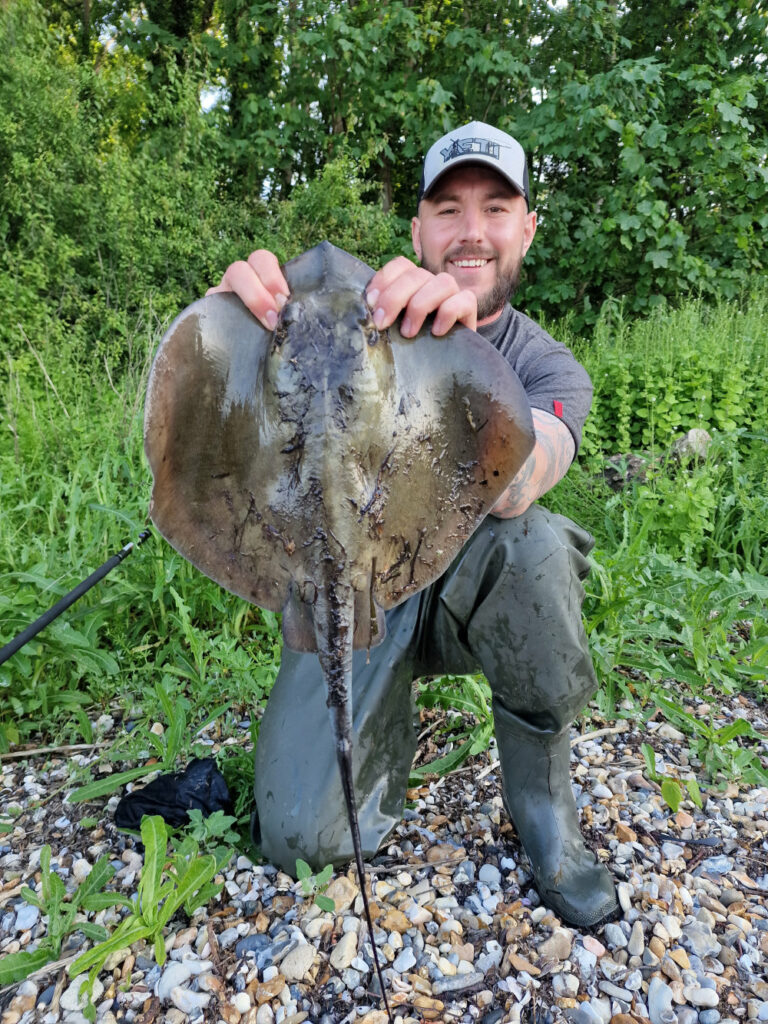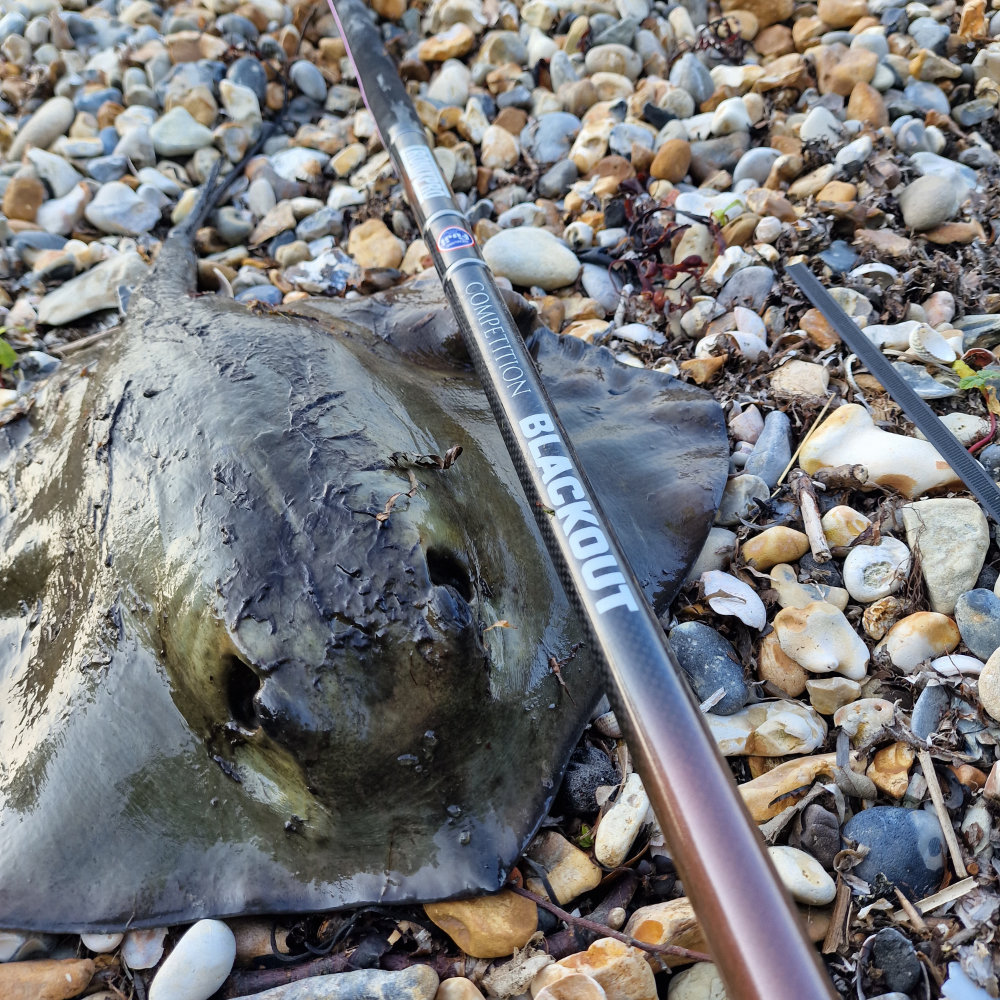Stingrays tend to be thought of as an almost exotic warm water species, yet the UK fish show in late spring when water temperatures are rising, yet overall remain quite low, struggling to exceed double figures. They grow big, with fish to 60lbs possible, and feasibly much bigger rays are always on the cards.

Season
Late April can see stingers from the English Channel marks around The Solent, but May and June are the key months with the Essex coast, especially St Osyth, selected Kent and Sussex beaches, again The Solent, all producing their share. In Wales, some can show from the Burry Holms area, but better chances exist inside Cardigan Bay with beaches at Borth, Barmouth and Pwllheli being the most likely. Odd fish can be taken as late as August, but your chances are less positive after mid July.
In Ireland, Fenit inside Tralee Bay is the hotspot, though occasional fish have shown from other southern Ireland venues. The fish stay later here, especially the sub 20lb fish that seem to stay in the surf right through to late September, around Castlegregory.
Habitat
They like mud/sand estuaries and work along the edges of the main channels looking for ground that is a mix of stone, boulders, bladderwrack, mud, and sand. They work this ground for crabs mainly. They will also feature inside smaller estuaries that are primarily sand, but again it’s the edges in the shallower water that draws them where the food is most abundant.
Surf beaches adjacent to estuaries will also produce, but it’s mainly the beaches on the side the tide floods from that carry the rays. They move with the tide down the beach to enter the estuary and once in the estuary tend to stay there unless pushed out by heavy flood water. It’s rare to get stingers on the beaches immediately downtide of the estuary mouth. On surf beaches they are often within 60-yards of the surf line, and if in doubt you’re better off fishing close than far. They are not afraid of shallow water and can sometimes be seen swimming with their backs out of the water.
Weather and Tides
Calm, settled, warm weather is ideal for stingers, especially if a high-pressure system is well established over a week or so. A gentle surf is best, and the more surf present the less likely you are to catch the bigger rays, the heavier surf pushing the rays out to deeper water. They will tolerate some waterborne sediment but prefer clear water.
The middle-sized tides climbing towards the bigger spring tides are the best just about everywhere, though the big tides can produce lesser numbers of fish. As the tides peak and start to reduce in size, then expect catches to fall away.
The stingers will start to work along the surf beaches and the estuary sides just after low water, but the best chance of success is in the middle three hours of the flood tide. If the weather is warm and sunny, even on overcast days, the shallow sand on the surf beaches and the mud and sand inside the estuaries will slowly heat up. As the new flood tide washes over this ground the water warms up, and it’s this that attracts the rays along with potential food.
An ebbing tide on the beaches is likely to be poor. If you fish the estuaries directly into the main channels deeper water, then you have a chance of a fish that is dropping back with the tide and holding up until the next flood.
Stingray can be caught in both daylight and at night, though daylight will usually produce the bulk of the fish.
Stingray Tackle
With big fish on the cards, strong tackle is needed. A rod around 13 to 14 ft and rated to cast up to 6 or 7 ozs is perfect, such as the Tronixpro Banzai Power or Tronixpro Competition Naga or Competition Blackout. Use either a medium-sized multiplier holding 300 yards of 20/25lb Xenon Mainline plus backing. Add a 60lb Tronixpro Xenon shock leader for casting and to combat rough ground abrasion. 8000 sized fixed spools such as the Tronixpro Xenon C-6 are an alternative reel.
Simple pulley rigs work best for shallow water stingray.
- Start with 60-inches of 80lb Tronixpro Xenon Leader.
- At one end, tie on a Tronixpro Big Bait Casting Snap to take the lead weight.
- Slide on a 5 mm rig bead, a Tronixpro Pulley Rig Bead and another 5 mm bead.
- 26-inches up from the free tag end of mono, tie in a figure of eight knot to form the hook length.
- On to the hook length, slide on a Tronixpro Crimp, a 3 mm bead, 8 mm bead, then tie on a size 4/0 to 6/0 Tronixpro Beast Uptide hook.
- Crimp the crimp lightly in place about an inch up from the hook eye. This should just slide on the hook length with finger pressure. This forms a bait stop to stop the bait blowing back onto the hook length during the cast.
Fish with a release wired lead, which will aid self-hooking. The pulley rig will see the lead weight slide up well above the fish to keep it well out of the way of snags and rocks.

Stingray Baits
If you stick with king ragworm or peeler crab, you won't go far wrong when targeting stingers. The odd one will take a mackerel section or squid bait, but the crab and rag reign supreme. Bait doesn't need to be massive either. A crab bait the size of a 50p piece is ample for average fish to 20lbs, or maybe twice as big if you feel there are big fish out there. A couple of decent sized king rag is also plenty for the rays to sniff out.
Tactics
It’s an advantage to fish two rods side by side on surf beaches and inside estuaries. Have one out at about 50-yards and the other closer at 30-yards. This maximises ground coverage. If you don’t get bites, cast the furthest out rod further still, but keep the close one as is, adjusting only as the tide floods in.
Stingrays usually just work along the surf line of beaches, but if you can locate any shallow gutters running parallel along the beach that carry the tide, then it’s worth dropping a bit in these.
In small estuary mouths, concentrate tight to the edges of any seed mussel beds or rocky outcrops. This sounds odd, but stingrays tend to swim in straight lines. What we mean by this is that they will follow the main contours of the channel edges. They won’t necessarily come into small shallow bays say 20 to 30-yards long that break up the main edge contour, so keep your bait in the mouth of these small bays, don’t drop closer.
You might see a few trembles on the rod tip as a ray takes the bait, followed by a steady pull over of the rod tip. This is a powerful take, so make sure your rod rest is well anchored. Also, bear in mind that the ray will have passed your bait, then passed through the scent trail downtide of the bait, meaning the fish turns back to face the tide then eats the bait as it approaches it. As soon as it has the bait in its mouth, it will swing back to swim with the tide, hence the powerful take.
There is little point in striking fish of this calibre, just lift the rod tip, let the line tighten and this naturally pulls the hook home.
A good tip to increase your chances is to throw old bait off the hook back out into the surf line. This will wash out and increase the scent value, making it more likely a passing ray will move in to investigate.
Stingrays get their name from the venomous spine or spines positioned at the tip of the tail. They can use this like a scorpion, so great care is needed when handling. Heavyweight industrial gloves are essential and use a cloth to hold the tail safely so you have full control when handling the fish. A length of broom handle can be laid across the tail to stop it driving forward, while you grab it just below the spines.


